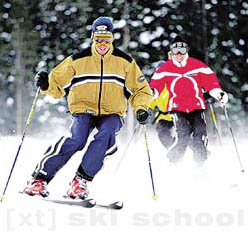|
The American Teaching System (ATS)
The teaching system currently used by U.S. instructors relies on four main components: the skills concept, skiing and teaching model, and centerline, which used in conjunction can produce ability advances in most skiers.
Skills concept
The first component, the skills concept is comprised of edging, pressure, steering and balance. These separate skills are usually reinforced by isolating the movement patterns used to apply the skill.
Edging is the act of creating angles in the body, which will vary the angle of the ski on the snow. As speed and terrain steepness increases the ski needs to be ridden on a higher edge in order for the steel edges to effectively cut into the snow. The skill of edging is of the utmost importance for skiers to effectively control speed and turning ability.
Pressure is the amount of weight applied to ski and in turn to the edge. The amount of pressure will effect how much the ski carves into the snow and controls speed. Pressure is unproportionately applied to the outside ski in a ratio of around 80% outside and 20% inside in most conditions. In high level conditions such as powder and soft moguls, the weight is distributed equally over both skis so they can be used as one platform.
Steering is the act of maneuvering the skis toward the intended direction of travel. The basic movement is made by simply twisting the foot around its axis. The twisting force is varied to allow for a greater change in direction. Steering is mainly effected by the countering of the body during a turn.
Balance is the art of staying in a position to effectively guide the skis either quickly or slowing in a long radius turn. By maintaining a strong sense of balance, you can achieve the most control. A forward balances position is favored by instructors as it promotes the ability to control the turning ability of the skis. Teachers attempt to instill in students the importance of returning to a centered position before the initiating of the new turn. Recentering is the single most important factor when teaching true parallel skiing.
Skiing model
The skiing model is the progression of maneuvers that allow skiers to reach the highest level of competence. The model starts out with the wedge continues into the beginning Christy, advanced Christy, parallel, dynamic parallel and diverging parallel. Skiers learn to ski the first maneuver and advance through the following levels.
Teaching model
The teaching model involves seven steps of teaching a proper lesson. These components are: introducing the learning segment, establishing goals, introducing material, demonstrating, guiding practice, checking for understanding, evaluation and teaching for transfer or introducing the next lesson. These parts given as a complete lesson will easily lend themselves to a good lesson.
The American Teaching System is student centered and outcome oriented, which means it is based solely on objectives set by the student and it is only successful when the established goals have been reached. The system is build around the theory that individuals comprise every class and instructors should zero in on the factors contributing to each skiers success. The system is not specific giving the instructors set instructions for teaching each class, but teachers are encouraged to develop unique and entertaining methods of skill acquisition.
The steering skill is unique to the U.S. and was first introduced back in the 70's in the American Teaching Method, ski instruction manual. Until this point ski instruction was standardized around the world by teaching beginners to edge their ski and apply weight to the outside ski while in the wedge to turn the ski. The ATS manual tells instructors to teach a tall stance with equal pressure on the skis and to use only the twisting action of the foot to turn the ski. Instructors today use both methods to teach skiing, but generally they attempt the steering method first.
Centerline
The centerline concept is built around touchstone maneuvers that are achieved as the skiers skill is increased; they are: The wedge turn, beginning and advanced Christy, open stance parallel and dynamic parallel. The moves are taught in that order and never varied. A variation does happen in the approach taken to learn the target move. Some ski teachers will use more edging skills to achieve the move, while other teachers will use more steering to achieve the same move. This lateral learning is based on student abilities to learn, but the abilities never change the sequence order.
***
Lake Effect Snow
Lake effect is when cool moist air blows over water which is still warm from the summer. The mystery of the lake effect is that the lakes produce narrow bands of snow that can carry a large amount of snow. In 1992 the Upper Peninsula saw a 42 inch overnight snowfall that only penetrated 20 miles inland from the shores of Lake Superior. Moisture in the clouds that make one inch of rain in the summer can make 30 inches of snow in the winter. In Buffalo New York the lake effect snow coming off Lake Erie marked a record snowfall as city snowplows worked for nineteen days to restore the roads to their pre-snowfall condition. City workers found themselves stranded in the offices for nine days before they could return home. Lake effect snow is a natural wonder and ski areas located in these natural snow belts often have a longer season than those that don't.
Alpine Skiing School section in english version of WWW.SKI.BG is based on
"A Guide To Becoming An Expert: From First Time To A Lifetime"
by John Mukavitz Copyright © 1998

|


